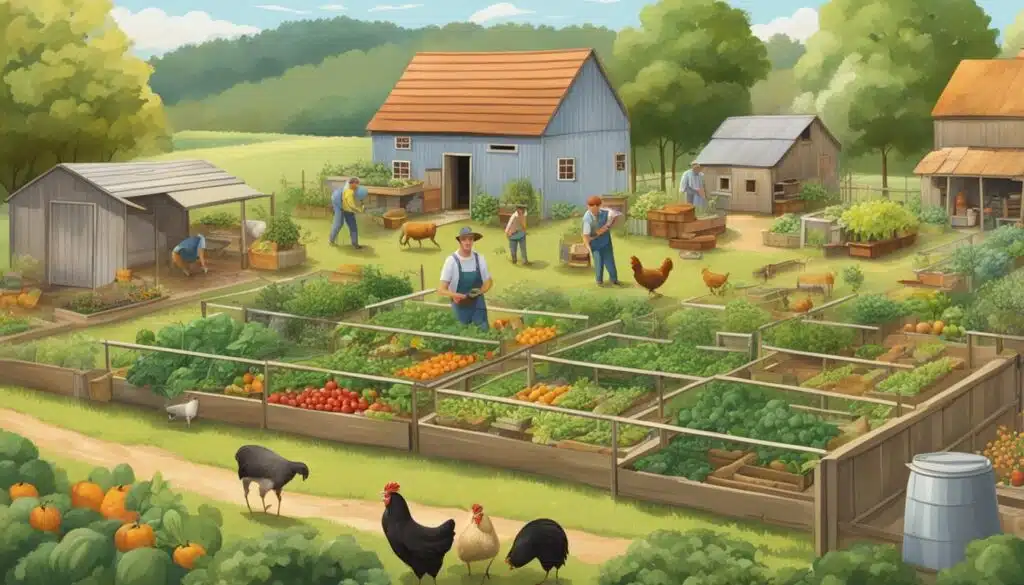
Homesteading represents a lifestyle of self-sufficiency and sustainability, reflecting a growing interest in personal and environmental health. It is characterized by a commitment to producing one’s own food, managing resources responsibly, and minimizing waste. This approach to living often involves a variety of skills such as gardening, animal husbandry, and DIY crafts that contribute not only to the individuals’ and households’ resilience but also benefit the community and the environment. The continuous development of these skills can lead to a profound sense of accomplishment and empowerment.

The benefits of homesteading extend beyond the tangible produce of one’s land. It can foster a strong sense of community as individuals often share their experiences, produce, and knowledge with others. This, in turn, can enhance relationships and mutual support among neighbors. Additionally, homesteading can serve as a crucial aspect of preparedness, providing families with the necessary skills and supplies to manage unforeseen circumstances efficiently.

The pursuit of self-sufficiency allows individuals and families to gain greater control over their finances, improve their health by consuming their own fresh, nutrient-rich foods, and boost their mental well-being through the satisfaction and happiness derived from a self-reliant lifestyle.
Self-sufficiency can lead to considerable savings as individuals become less reliant on purchasing from stores. Growing one’s own food can significantly reduce grocery store bills. By producing goods at home, households can save money that would otherwise be spent on commercial items. Furthermore, the long-term investment in homesteading infrastructure can decrease living costs over time, making this lifestyle more affordable.
Homesteading promotes consuming fresh food, free from pesticides, which can offer impressive health benefits. When individuals grow their own food, they have access to a wide variety of nutrients that are essential for a healthy lifestyle. Control over one’s diet by choosing what to plant and harvest means better quality control of the food that makes it to the table.
The act of homesteading provides mental health advantages such as increased satisfaction and happiness. Self-sufficiency requires problem-solving and continuous learning, which keeps the mind engaged and motivated. The independence garnered from managing one’s own resources reinforces a sense of accomplishment and can significantly enhance overall psychological well-being.
Homesteading requires a diverse set of skills and knowledge that range from growing food to raising animals and building infrastructure. Success in homesteading comes through combining practical skills with a deep understanding of the natural world.

One initiates a homestead garden by planning the layout and selecting vegetables that thrive in the local climate. Research is essential to understand soil quality and to determine the best garden practices for each plant type. For a successful vegetable garden, knowledge of seasonal planting and seed starting is key. Composting enriches the soil and reduces waste, creating a sustainable cycle for plant growth.
Skills to Develop:
Essential Knowledge:
To maintain a diverse homestead, one must acquire animal husbandry skills, focusing on the care of livestock such as chickens, goats, and cows. Feeding, sheltering, and health management are all crucial to producing high-quality meat and eggs. Planning for routine care and emergency situations are aspects of sound animal husbandry.
Skills to Develop:
Essential Knowledge:
Constructing reliable shelter for both humans and animals is a cornerstone skill in homesteading. This involves understanding how to use various tools and materials, as well as crafts to create not only buildings but also necessary equipment. Knowledge of basic carpentry and construction, coupled with the ability to read and create blueprints, is crucial for erecting structures that are safe and enduring.
Skills to Develop:
Essential Knowledge:

In the realm of homesteading, efficient resource management stands as a cornerstone for self-sufficiency and environmental stewardship. This process encompasses the judicious utilization of natural assets, sustainable practices to minimize environmental impact, and methods for effective food preservation.
Homesteaders often turn to solar panels as a means of harnessing renewable energy, reducing dependence on conventional electricity sources. The allocation of budget for such investments results in long-term savings and promotes the use of sustainable resources. Additionally, designing homestead fencing with careful consideration of material costs and land resources can prevent unnecessary expenditure and surplus.
Homesteading offers a unique platform to directly reduce greenhouse gas emissions through environmentally friendly practices. By managing resources such as land and water sustainably, homesteaders play an active role in environmental preservation.
Food preservation stands as a fundamental element of homestead resource management, enabling individuals to stabilize their harvest yield throughout the year.
By focusing on these aspects of resource management, homesteaders create resilient systems that are both economical and sustainable, which can lead to a more harmonious relationship with the environment.

The homesteading lifestyle embraces a proactive relationship with both the community and the natural environment. It promotes a balanced life that weaves personal development with cultivating strong ties to family and friends.
In homesteading, the value of collaboration and community support is paramount. Families often engage in sharing resources, such as tools and harvests, which strengthens friendships and the sense of belonging. The practice of Urban homesteading highlights an avenue for city dwellers to connect with neighbors through shared garden spaces and local markets, turning anonymity into close-knit communities.
Homesteading involves a dedication to living off the land, maximizing space for farming, and cultivating a relationship with nature and wildlife. This connection to the land often leads to a sustainable, off-the-grid lifestyle, allowing more privacy and self-sufficiency. A strategy for ecological restoration leverages this principle for the betterment of both the environment and community.
Engagement in homesteading tasks fosters a strong work ethic and a culture of creation and self-reliance. Continuous learning and growth are fundamental, as homesteaders often acquire and refine a variety of skills, from carpentry to gardening. This hands-on lifestyle contributes to significant personal growth, with the benefits of living a homestead life in Maine serving as testimony to these individual benefits.
Homesteading offers a unique approach to preparedness and survival, empowering individuals with the means for self-reliance during crises and the tools for achieving greater financial security.
In emergencies, the ability to sustain oneself is crucial. Homesteaders reduce dependence on external services by producing their own food, water, and energy. They often have savings on food expenses and are less affected by the loss of supply chains during disasters. This self-sufficient lifestyle mitigates the pressure exerted by external crises, ensuring that one’s basic needs are met independently.
The principles of homesteading extend beyond immediate survival needs, fostering long-term financial security and planning. By managing one’s own resources and reducing reliance on purchased goods, homesteaders can accumulate significant savings. Living a self-sufficient lifestyle also instills discipline in finances, as they prioritize investments in tools and infrastructure that yield returns in sustainability, thus reinforcing their independence.
This section provides insights into common inquiries about homesteading, exploring the lifestyle’s benefits, financial implications, and strategies for self-sufficient living.
Homesteading offers numerous benefits, including increased self-reliance, the ability to produce one’s own food, and a deeper connection to nature. This Urban Homesteading book provides valuable insights into these advantages through real-life stories and guidance.
By cultivating their own food and reducing reliance on purchased goods, homesteaders often experience lower living expenses. Homesteading can also include generating income through selling excess produce or homemade products, which is elaborated upon in the article Why the homesteading data are so poor.
Homesteading emphasizes sustainable practices like organic gardening, conservation of resources, and renewable energy use. A study on Homesteading in Maine notes that these methods lead to a smaller carbon footprint and greater self-sufficiency.
Legal homestead protection can provide tax benefits and safeguard against loss due to debt or bankruptcy. Financial distinctions revolve around the potential for reduced property taxes and how each type of property is treated legally, as outlined in legal texts and studies like On Becoming a Homesteader.
Getting started with homesteading typically involves small, manageable steps, such as establishing a garden, learning food preservation techniques, and acquiring practical DIY skills. This journey is detailed in books like At home in nature: Modern homesteading and spiritual practice in America.
Many homesteaders find that the lifestyle promotes a balanced life through physical activity, stress reduction, and a sense of accomplishment. Engaging in homesteading can increase one’s mindfulness and overall life satisfaction.